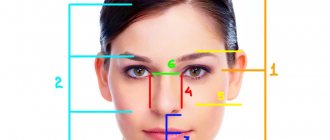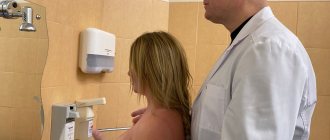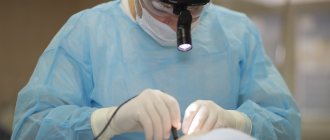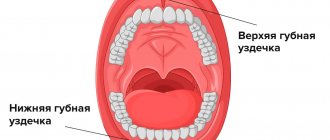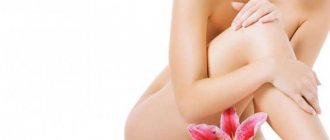Description of the technique
VY lip surgery involves a complex of various manipulations that will help reconstruct the lips. Doctors use modern devices, instruments and are guided by innovative techniques to eliminate various deformities of the oral cavity.
After the operation, the lips acquire a seductive volume: the height of the upper lip increases, the horizontal size often decreases, and a so-called “bow” shape is obtained. The effect is visible immediately, which is very important - it is very natural and there are no external traces of the operation.
Stages of lip augmentation surgery
The entire VY cheiloplasty technique consists of the following important steps:
- Before the procedure, the patient must undergo the necessary medical examination and also consult with the attending physician.
- Submission of laboratory tests.
- The patient is given general or local anesthesia.
- The doctor makes a V-shaped incision on the inside of the upper or lower lip. The excess skin is removed, and the remaining edges are joined using an absorbable Y-shaped suture.
The duration of the lip augmentation procedure in our clinic does not take more than 60 minutes. To reduce swelling of the skin, girls are given a bandage with ice or special cooling agents. The recovery period lasts about two weeks.
What is cheiloplasty?
A plastic surgery method aimed at correcting defects in the lip area in order to improve their appearance. There are incisional (carried out by cutting tissue) and injection techniques. Cheiloplasty allows you to achieve natural proportions, symmetrical contours and ideal lip shape.
Cheiloplasty at the Kivach clinic
Plastic surgeons at the clinic recommend that you undergo the “Body Cleansing” program before surgery. This normalizes the physiological balance and minimizes possible risks of complications during surgery and during the recovery period.
After surgery, patients are offered comprehensive programs to accelerate the healing of postoperative wounds and reduce swelling. These programs can reduce the rehabilitation period by an average of 2 times.
Check out our programs
OPTIMUM for face
OPTIMUM for the body
PREMIUM for face
PREMIUM for body
Indications
- Lip asymmetry.
- Age-related changes in the lips.
- Insufficient lip volume.
- Drooping of the corners of the mouth.
- Residual deformities after operations in the lip area.
- Correction of congenital anomalies.
results
- Elimination of lip asymmetry.
- Increased lip volume.
- Tightened corners of the mouth.
- Rejuvenating lifting of the upper lip.
- Giving lips natural proportions and aesthetic appeal.
Photos before and after
About the operation
Operation duration:
from 30 minutes to several hours. The duration may be increased for medical reasons.
Duration of the rehabilitation period:
from several days to several weeks depending on the volume of the operation.
Effect:
depending on the method, the effect can be assessed after 2-3 weeks - 1-2 months.
Where is it used?
Oral rejuvenation
Wrinkles in the mouth area are smoothed out, lips acquire a healthy tint. The drooping corners are raised.
Increased lip volume
The volume of the lips increases and their asymmetry is eliminated.
Upper lip lift
The height of the skin part of the upper lip decreases.
Cheiloplasty technique
Before undergoing cheiloplasty, it is necessary to consult a specialist and undergo a comprehensive examination, including tests.
Download our guide to find out what tests you need to complete.
Depending on the task, lip correction at the Kivach clinic is carried out using two methods - injection and incision.
Injection cheiloplasty
This procedure is similar to contouring in cosmetology. It is performed under local anesthesia (pain relief). The following are used as injectable fillers:
Biogels based on hyaluronic acid
. They are administered using injections along the contour or into the thickness of the lips, depending on the correction task. They act as fillers that increase volume and correct contours. After 6-12 months they resolve.- The patient's own adipose tissue (lipofilling)
. Fat tissue is transplanted from another area of the body to the lips, correcting their volume and shape. If you follow medical recommendations (including nutritional recommendations), your own adipose tissue will provide a longer-lasting effect than hyaluronic acid-based fillers.
Incisional cheiloplasty
Surgical methods. Operations are performed under local or general anesthesia. Depending on the goals set, they are carried out according to the following schemes:
- VY – plastic
. A surgical operation aimed at increasing the volume of the lips. On the mucous surface of the lip, the surgeon makes a series of incisions in the shape of the letter V and redistributes the tissue of the lip, which helps to increase its width and volume. The lip is fixed in a simulated state (in the shape of the letter Y) by applying sutures. Used on the upper and lower lip. - Bullhorn plastic
. Surgical shortening of the skin of the upper lip (reducing the height of the skin above the upper lip). The incision is made under the base of the nasal septum and wings of the nose. The skin above the lips tightens, lifting the upper lip. - Plastic Corner lift
. Surgical method of lifting the corners of the lips. Small sections of tissue are excised above the corners of the upper lip, which directs the lip line upward.
During the consultation, the clinic’s plastic surgeon will listen to your wishes, conduct an examination,, if necessary, prescribe additional studies and suggest correction methods that best suit you.
To get a consultation
Contraindications
- Blood clotting disorders.
- Systemic diseases.
- Oncological diseases in acute form and remission, lasting less than 5 years.
- Immunodeficiency states.
- Labial herpes (cold on the lips) in the acute stage.
- Pregnancy, lactation.
Question answer
- When can the result be assessed?
- The result is assessed depending on the chosen method of lip correction. When introducing fillers, the primary result can be assessed immediately after the procedure. The final one is formed 2-3 weeks after the injection contents are evenly distributed under the skin. The result after surgical (incisional) cheiloplasty can be assessed 1-2 months after the complete disappearance of swelling and redness.
- What result should you expect?
- Cheiloplasty, regardless of the chosen method, effectively eliminates aesthetic problems in the mouth.
- With the injection method, fillers are injected into problem areas of the lips, forming the required volume. At the same time, the process of tissue bioreinforcement (strengthening the collagen frame) is launched, the production of collagen fibers and a number of other restoration processes are activated.
Surgical (incisional) cheiloplasty is usually performed once.
- Is the operation safe?
- Surgeries to correct the shape of the lips are well tolerated by patients. Incisional cheiloplasty is performed using local or general anesthesia.
- How to prepare for surgery?
- Preparation for surgery involves examination by specialists and undergoing laboratory and instrumental tests.
Important doctor's advice:
- 14 days before surgery, it is advisable to quit smoking.
10 days before surgery - do not take painkillers or anti-inflammatory drugs (NSAIDs).
- How long is the rehabilitation period?
- The duration of the recovery period depends on the chosen method of lip correction. Injection techniques do not imply a rehabilitation period. There may be slight swelling and minor pain that disappears within 1-2 days. In fact, patients can return to their normal lifestyle immediately after filler injection. Exposure to UV rays and visits to the solarium should be avoided for 2 weeks.
After surgical cheiloplasty, the sutures dissolve on the 7-10th day; swelling and numbness may persist for 2 weeks.
To reduce postoperative rehabilitation, patients at the clinic are offered comprehensive programs of restorative procedures to speed up tissue healing.
- Are there any complications?
- Complications are practically excluded. Swelling, bruising, and hyperemia (redness) are possible. These are natural manifestations that occur during the postoperative period. To minimize the risk, it is recommended to undergo the “Cleanse the Body” program.
- What guarantees the success of the operation?
- Certified plastic surgeons.
- Compliance with medical standards.
- Completing the “Body Cleansing” program before surgery minimizes the risk of complications.
- Completing any of the comprehensive programs after surgery will shorten the rehabilitation period.
As a result, it becomes possible to model the contour, shape and volume of the lips, and eliminate possible asymmetry.
The cost of the operation does not include the cost of anesthesia
Cheiloplasty (changing the shape and volume of the lips)
| Name of procedure | Cost of one procedure (RUB) |
| Lip augmentation (VY labiaplasty) – upper lip | 30 450 |
| Lip augmentation (VY labiaplasty) – lower lip | 30 450 |
| Shortening – lifting of the upper lip (Operation Bullhorn) | 36 750 |
Contraindications
- diabetes;
- poor blood clotting;
- diseases of the oral cavity, including herpes;
- oncological formations in the body;
- During pregnancy and breastfeeding;
- infectious diseases;
- chronic diseases.
To have lip augmentation using the VY technique or other plastic surgery in Moscow with professional doctors, leave a request for an appointment and you will be contacted as soon as possible. Or contact the clinic yourself by calling 8-917-500-500-3.
Plastic surgeons who specialize in lip surgery, including Maria Grigorievna Levitskaya and Ilona Sergeevna Kochneva, tell
VY-plasty allows you to increase the volume of the red border of the upper and/or lower lip. The effect of volumetric enlargement is achieved using two components:
1. By moving the mucous membrane from the oral cavity to the red border, which leads to an increase in its surface area.
2. And also due to the planar scar, which is formed under the mucosa after its detachment and upon completion of the maturation process will increase the thickness of the mucosa.
This is why lips look beautiful 3-4 months after surgery, and even more beautiful, smooth, symmetrical and voluminous after 6-9 months. Also, using the vivai plasty, you can moderately invert the lip (for a more significant inversion of the lip, it is necessary to shorten the skin part of the upper lip, and only a bullhorn can cope with this). However, it is almost impossible to change the contour of the lip and lift the corners of the mouth using this operation.
Vivail is performed from the mucosal side. Peeling off the mucous membrane, the plastic surgeon pushes it out, thereby giving volume to the lip. This is done using V-shaped incisions, which, after detachment, are stitched in the shape of the letter Y. This technique is a type of plastic surgery with local tissues, which came into aesthetics from reconstructive medicine, where it was used to give volume/gain to tissues in places of their deficiency ( for example, with scar lesions).
Degree of increase in lip volume
after VY-plasty depends on the initial volume of the lips, the width of the red border and the thickness of the orbicularis oris muscle. And also on the area of detachment, which should be wider than the V-shaped incisions themselves. But vivai surgery is not 100% predictable. In one patient, we can get a gain of 5-7 mm from a thin lip. And for another with the same thin lips we get only 2-3 mm. It all depends on the thickness of the mucous membrane. The thicker it is, the brighter the result will be. And thick and elastic mucosa is more common in very young patients. The older we get, the more the tissues atrophy, and the mucous membrane becomes thinner as well.
Of course, a lot depends on the quality of the mucous membrane, so it cannot be said that vivai is suitable only for very young patients. Some patients, even after 40 years, have better mucous membranes than young girls who abuse fillers for lip augmentation. There are many techniques when fillers are injected uncontrolled and intradermally, very close to the surface of the mucosa. This leads to thinning, sagging and impaired blood supply to the mucosa, which increases the risk of ischemia and necrosis in the early postoperative period and leads to rough, uncontrolled scarring.
By the way! Fillers must be removed before lip surgery! We prescribe it twice: 4 weeks, and then 2 weeks before surgery, since the filler cannot be completely removed at one time. Fillers should not be removed the day before surgery. It is important that the interval between the operation and the administration of lidase/longidase is at least 10-14 days, because after the administration of this drug, the mucous membrane becomes very loose and flabby for some time, which significantly increases the risk of ischemia and hematomas after surgery.
I would like to draw special attention to the fact that vivai involves the advancement of your own oral mucosa. And the mucous membrane of absolutely everyone is uneven: initially there are recesses and cracks of varying depths, the thickness of the mucous membrane in the oral cavity is greater than in the part that covers the red border. Also, all have an asymmetry in volume, contour and thickness of the red border.
Therefore, after cheiloplasty, existing retractions may remain (at extreme levels of severity, they seem to divide the lip into two parts), deform the inner contour of the lips, and become more noticeable, especially when smiling. Also (rather rarely) the boundary between the thinner mucosa in the red border and the thicker mucosa in the mouth is preserved after expulsion. If this happens, then in the area of such defects the mucous membrane is cut with a cannula and the gel is injected. It is important to do this in the early stages after surgery, and then the defects are straightened out, there is no rough scarring and the lips become smooth.
For older patients and in cases where the upper lip is very thin and its skin part is long, we always combine vivay with bullhorn: in order to additionally evert the lip and so that the pushed out mucous membrane has room to straighten out.
After VY-plasty there is a difficult postoperative period
. This type of operation is characterized by very pronounced swelling, which persists for 3 weeks. The larger the swelling and the longer it persists, the more pronounced the result of increasing volume will be in the end. If fillers were injected before surgery, you should expect very large and prolonged swelling.
Bleeding and bruising is a different story. They are always there. They are always extensive and asymmetrical: they may be present on one side and absent on the other. Bruises on the lip look scary - they are black. There is no need to be scared, but you must strictly follow the recommendations given by the doctor. Until the 7th day after surgery, you should not put pressure on your lip; you must constantly moisturize it, eat soft and crushed food, and limit facial expressions as much as possible. Bruises completely disappear only after 2-3 weeks.
Starting from the 7th day, two types of scars are formed:
1. Linear in the area of postoperative sutures.
2. Flat over the entire surface of the exfoliated mucosa on the red border and inside the mouth.
The sutures with self-absorbing threads have already dissolved, and the scars begin to pull the lip inward, it begins to curl up. As the swelling subsides (7-10 days), the lip becomes dense, as if “wooden”. At this moment, you need to include facial gymnastics, self-massage, and it is also important to smile widely. In addition, there are special procedures for faster softening of the lip, for example, the introduction of lidase (only by the doctor who performed the operation!). If you don’t massage your lip or do anything with it, it will remain wrapped for a very long time.
During the first time after surgery, sensitivity is impaired. The feeling that after vivaplasty the lips are like after anesthesia. Sensory fibers and nerves that were cut during surgery need time to grow. At first, the lips do not feel anything, then gradually sensations begin to appear and only a small strip remains in the area where the red border transitions into the mucous membrane, in which sensitivity is the last to be restored.
In rare cases, areas of superficial ischemia and local necrosis of the mucosa may be visible already on days 5-7. They look like areas of darkening, surrounded by a rim of pink-yellow tissue. Again: don't be scared. It is necessary to follow the doctor’s instructions and constantly apply ointments to these areas, keeping them moisturized, which will allow the mucous membrane to “tighten” the resulting defect much faster without visible deformation.
In even more rare cases, a dense scar (retraction) will appear in this place. It needs to be softened with the help of longidase and stretched with the help of facial gymnastics and massage, and when it becomes soft, a filler must be injected under it, which will return the lip to its beautiful shape. As a rule, 1-2 injections are necessary until the lip is completely restored - the mucous membrane regenerates very well.
All muscle movements are preserved after surgery. Therefore, there cannot be a situation where food falls out of your mouth. Food falls out when the botulinum toxin injection is unsuccessful and the muscles do not move. After VY there is no such thing.
But facial expressions after cheiloplasty take quite a long time to recover, which is associated with the scarring process. Ugly facial expressions last for 1-2 months, rarely up to three. During this period, the smile will not be beautiful, you will not be able to smile from all your mouth.
To speed up recovery, 7 days after surgery, we recommend massaging your lips with your tongue and smiling broadly—stretching your lips in facial expressions. And starting from two weeks after the operation, active massage: knead your lip with your fingers and smile even wider. The criterion for the effectiveness of massage and smiling is the feeling of discomfort when performing them. The scars that pull the lips inward will gradually soften. And once again I would like to remind you: all “suffering” in the postoperative period is temporary. And what causes discomfort (swelling and scars), upon completion of rehabilitation, will lead to an increase in volume and the creation of a beautiful lip shape.
Many people complain that their lips become dry after surgery. But two concepts are often confused: dryness of the mucous membrane (it requires constant hydration and fatty ointments) and tightening, which is caused by internal scars.
The mucous membrane dries for quite a long time after cheiloplasty, which is easily explained: the mucous membrane of the oral cavity is always moist, and after “pushing out” it begins to dry out. Cells need time to rebuild and get used to new living conditions. This period lasts on average 3-6, but in some cases up to 8 months. We recommend using moisturizing lipsticks, bepanthen, and lip gloss. In order to deal with scars, you need to do self-massage, knead and perform facial exercises.
It is very important to go to your doctor for checkups. We have a rule - we examine patients daily for the first week, then once a week for the first month. And then we increase the interval to two weeks.
After all the difficulties described above, you can say: “Fuck it! Why do this cheiloplasty? I will continue to introduce fillers!” However, in our opinion, hairplasty (and, in particular, viva) is a plastic surgery that allows you to transform not only your lips. The whole face changes after a competently performed operation, becoming more youthful and prettier. Lip augmentation with fillers must be repeated and, with age, more often and in larger volumes, and the result will be less stable and less and less aesthetic. After all, with age, unfortunately, atrophy of the mucous membrane occurs. By the way, necrosis and ischemia have recently occurred more and more often (from illiterate or intramucosal injection of fillers), just look for information on cosmetologist forums to be convinced of this. Let’s not forget those cases when it is impossible to correct a very thin lip with fillers (the filler migrates into the skin part and the lip becomes like a “duck”).
Cheiloplasty: one operation, one rehabilitation period, and the result is stable and the lips look natural.
To communicate with patients who have undergone cheiloplasty, come to our forum in the section Other plastic surgeries in the face and head
This is not a public offer! There are contraindications. Before use, consultation with a specialist is required.

